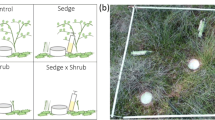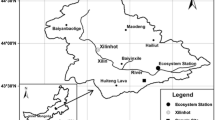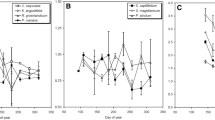Abstract
Aims
This study assesses the relative effects of hydrology and colonization by vascular plants on belowground C and N mobilization, and emission of CO2 and CH4 in an extracted bog under restoration in Alberta (Canada).
Methods
A wet (high water table) and dry (low water table) area were identified at the site and plots with cottongrass (Eriophorum vaginatum) or bare peat were established in each area. Plant growth, peat and porewater dissolved C (DOC) and N (TDN), microbial biomass and the emissions of CO2 and CH4 were monitored at the plots throughout the growing season.
Results
The largest concentrations of DOC were measured in dry and bare sites. Lower E2:E3 ratios suggested a higher aromaticity of the DOC at these sites that were net sources of CO2 and CH4. The concentration of TDN was greater in plots with cottongrass and high water table, supporting a more abundant microbial biomass. Cottongrass dominated plots also had larger gas emissions as compared to bare plots even though they were net C sinks due to their high photosynthetic rates.
Conclusion
Maintaining a high water table is key to reducing peatland C losses. While vascular plant presence seems to prime the release of N and greenhouse gases, the inputs of C exceeded the losses and recovered the C sink function of the peatland ecosystem in the short term. Carbon inputs are maximized under high water table and plant presence.





Similar content being viewed by others
References
Abdalla M, Hastings A, Truu J, Espenberg M, Mander Ü, Smith P (2016) Emissions of methane from northern peatlands: a review of management impacts and implications for future management options. Ecol Evol 6:7080–7102. https://doi.org/10.1002/ece3.2469
Armstrong A, Holden J, Luxton K, Quinton JN (2012) Multi-scale relationship between peatland vegetation type and dissolved organic carbon concentration. Ecol Eng 47:182–188. https://doi.org/10.1016/j.ecoleng.2012.06.027
Armstrong A, Waldron S, Ostle NJ, Richardson H, Whitaker J (2015) Biotic and abiotic factors interact to regulate northern Peatland carbon cycling. Ecosystems 18:1395–1409. https://doi.org/10.1007/s10021-015-9907-4
Basiliko N, Stewart H, Roulet NT, Moore TR (2012) Do root exudates enhance peat decomposition? Geomicrobiol J 29:374–378. https://doi.org/10.1080/01490451.2011.568272
Bhullar GS, Edwards PJ, Olde Venterink H (2013) Variation in the plant-mediated methane transport and its importance for methane emission from intact wetland peat mesocosms. J Plant Ecol 6:298–304. https://doi.org/10.1093/jpe/rts045
Brooks ML, Meyer JS, McKnight DM (2007) Photooxidation of wetland and riverine dissolved organic matter: altered copper complexation and organic composition. Hydrobiologia 579:95–113. https://doi.org/10.1007/s10750-006-0387-6
Brummell ME, Lazcano C, Strack M (2017) The effects of Eriophorum vaginatum on N 2 O fluxes at a restored, extracted peatland. Ecol Eng 106:287–295. https://doi.org/10.1016/j.ecoleng.2017.06.006
Cabezas A, Gelbrecht J, Zwirnmann E et al (2012) Effects of degree of peat decomposition, loading rate and temperature on dissolved nitrogen turnover in rewetted fens. Soil Biol Biochem 48:182–191. https://doi.org/10.1016/j.soilbio.2012.01.027
Cooper MDA, Evans CD, Zielinski P, Levy PE, Gray A, Peacock M, Norris D, Fenner N, Freeman C (2014) Infilled ditches are hotspots of landscape methane flux following Peatland re-wetting. Ecosystems 17:1227–1241. https://doi.org/10.1007/s10021-014-9791-3
Crow SE, Wieder RK (2005) Sources of co 2 emission from a northern PEATLAND: root respiration, exudation, and decomposition. Ecology 86:1825–1834. https://doi.org/10.1890/04-1575
Del Giudice R, Lindo Z (2017) Short-term leaching dynamics of three peatland plant species reveals how shifts in plant communities may affect decomposition processes. Geoderma 285:110–116. https://doi.org/10.1016/j.geoderma.2016.09.028
Dieleman CM, Lindo Z, McLaughlin JW et al (2016) Climate change effects on peatland decomposition and porewater dissolved organic carbon biogeochemistry. Biogeochemistry 128:385–396. https://doi.org/10.1007/s10533-016-0214-8
Dinsmore KJ, Skiba UM, Billett MF, Rees RM (2009) Effect of water table on greenhouse gas emissions from peatland mesocosms. Plant Soil 318:229–242. https://doi.org/10.1007/s11104-008-9832-9
Doane TA, Silva LCR, Horwath WR (2019) Exposure to light elicits a Spectrum of chemical changes in soil. J Geophys Res Earth Surf 124:2288–2310. https://doi.org/10.1029/2019JF005069
Edwards KR, Kaštovská E, Borovec J, Šantrůčková H, Picek T (2018) Species effects and seasonal trends on plant efflux quantity and quality in a spruce swamp forest. Plant Soil 426:179–196. https://doi.org/10.1007/s11104-018-3610-0
Evans C (2015) Old carbon mobilized. Nat Geosci 8:85–86. https://doi.org/10.1038/ngeo2334
Evans CD, Renou-Wilson F, Strack M (2016) The role of waterborne carbon in the greenhouse gas balance of drained and re-wetted peatlands. Aquat Sci 78:573–590. https://doi.org/10.1007/s00027-015-0447-y
Evans CD, Peacock M, Green SM et al (2018) The impact of ditch blocking on fluvial carbon export from a UK blanket bog. Hydrol Process 32:2141–2154. https://doi.org/10.1002/hyp.13158
Frank S, Tiemeyer B, Gelbrecht J, Freibauer A (2014) High soil solution carbon and nitrogen concentrations in a drained Atlantic bog are reduced to natural levels by 10 years of rewetting. Biogeosciences 11:2309–2324. https://doi.org/10.5194/bg-11-2309-2014
Gavazov K, Albrecht R, Buttler A et al (2018) Vascular plant-mediated controls on atmospheric carbon assimilation and peat carbon decomposition under climate change. Glob Change Biol 24:3911–3921. https://doi.org/10.1111/gcb.14140
Glatzel S, Basiliko N, Moore T (2004) Carbon dioxide and methane production potentials of peats from natural, harvested and restored sites, eastern Québec, Canada. Wetlands 24:261–267. https://doi.org/10.1672/0277-5212(2004)024[0261:CDAMPP]2.0.CO;2
Gorham E (1991) Northern Peatlands: role in the carbon cycle and probable responses to climatic warming. Ecol Appl 1:182–195. https://doi.org/10.2307/1941811
Graf M, Rochefort L (2009) Examining the peat-accumulating potential of fen vegetation in the context of fen restoration of harvested peatlands. Écoscience 16:158–166. https://doi.org/10.2980/16-2-3128
Grayson R, Holden J (2012) Continuous measurement of spectrophotometric absorbance in peatland streamwater in northern England: implications for understanding fluvial carbon fluxes. Hydrol Process 26:27–39. https://doi.org/10.1002/hyp.8106
Greenup AL (2000) The role of Eriophorum vaginatum in CH4 flux from an ombrotrophic peatland. Plant Soil 227:265–272. https://doi.org/10.1023/A:1026573727311
Guigue J, Mathieu O, Lévêque J et al (2014) A comparison of extraction procedures for water-extractable organic matter in soils: comparison of WEOM extraction procedures. Eur J Soil Sci 65:520–530. https://doi.org/10.1111/ejss.12156
Helms JR, Stubbins A, Ritchie JD et al (2008) Absorption spectral slopes and slope ratios as indicators of molecular weight, source, and photobleaching of chromophoric dissolved organic matter. Limnol Oceanogr 53:955–969. https://doi.org/10.4319/lo.2008.53.3.0955
Holden J (2005) Peatland hydrology and carbon release: why small-scale process matters. Philos Trans R Soc A Math Phys Eng Sci 363:2891–2913. https://doi.org/10.1098/rsta.2005.1671
IPCC (2014) 2013 Supplement to the 2006 IPCC guidelines for National Greenhouse gas Inventories: wetlands. The intergovernmental panel on climate change (IPCC), Switzerland
Järveoja J, Peichl M, Maddison M et al (2016) Impact of water table level on annual carbon and greenhouse gas balances of a restored peat extraction area. Biogeosciences 13:2637–2651. https://doi.org/10.5194/bg-13-2637-2016
Jordan S, Strömgren M, Fiedler J (2016) Ecosystem respiration, methane and nitrous oxide fluxes from ecotopes in a rewetted extracted peatland in Sweden. Mires and Peat 1–23. https://doi.org/10.19189/MaP.2016.OMB.224
Kalbitz K, Geyer S (2002) Different effects of peat degradation on dissolved organic carbon and nitrogen. Org Geochem 33:319–326. https://doi.org/10.1016/S0146-6380(01)00163-2
Kuiper JJ, Mooij WM, Bragazza L, Robroek BJM (2014) Plant functional types define magnitude of drought response in peatland CO 2 exchange. Ecology 95:123–131. https://doi.org/10.1890/13-0270.1
Lavoie C, Grosvernier P, Girard M, Marcoux K (2003) No title found. Wetl Ecol Manag 11:97–107. https://doi.org/10.1023/A:1022069808489
Lavoie C, Marcoux K, Saint-Louis A, Price JS (2005) The dynamics of a cotton-grass (Eriophorum vaginatum L.) cover expansion in a vacuum-mined peatland, southern Québec, Canada. Wetlands 25:64–75. https://doi.org/10.1672/0277-5212(2005)025[0064:TDOACE]2.0.CO;2
Lazcano C, Robinson C, Hassanpour G, Strack M (2018) Short-term effects of fen peatland restoration through the moss layer transfer technique on the soil CO2 and CH4 efflux. Ecol Eng 125:149–158. https://doi.org/10.1016/j.ecoleng.2018.10.018
Leiber-Sauheitl K, Fuß R, Voigt C, Freibauer A (2014) High CO 2 fluxes from grassland on histic Gleysol along soil carbon and drainage gradients. Biogeosciences 11:749–761. https://doi.org/10.5194/bg-11-749-2014
Lou X-D, Zhai S-Q, Kang B, Hu YL, Hu LL (2014) Rapid response of hydrological loss of DOC to water table drawdown and warming in Zoige Peatland: results from a Mesocosm experiment. PLoS One 9:e109861. https://doi.org/10.1371/journal.pone.0109861
Mahmood MS, Strack M (2011) Methane dynamics of recolonized cutover minerotrophic peatland: implications for restoration. Ecol Eng 37:1859–1868. https://doi.org/10.1016/j.ecoleng.2011.06.007
Marinier M, Glatzel S, Moore TR (2004) The role of cotton-grass ( Eriophorum vaginatum ) in the exchange of CO 2 and CH 4 at two restored peatlands, eastern Canada. Écoscience 11:141–149. https://doi.org/10.1080/11956860.2004.11682818
Mastný J, Kaštovská E, Bárta J et al (2018) Quality of DOC produced during litter decomposition of peatland plant dominants. Soil Biol Biochem 121:221–230. https://doi.org/10.1016/j.soilbio.2018.03.018
Min J-Y, Min K-B (2016) Blood trihalomethane levels and the risk of total cancer mortality in US adults. Environ Pollut 212:90–96. https://doi.org/10.1016/j.envpol.2016.01.047
Murphy MT, Moore TR (2010) Linking root production to aboveground plant characteristics and water table in a temperate bog. Plant Soil 336:219–231. https://doi.org/10.1007/s11104-010-0468-1
Nichols JE, Peteet DM (2019) Rapid expansion of northern peatlands and doubled estimate of carbon storage. Nat Geosci 12:917–921. https://doi.org/10.1038/s41561-019-0454-z
Nugent KA, Strachan IB, Strack M et al (2018) Multi-year net ecosystem carbon balance of a restored peatland reveals a return to carbon sink. Glob Change Biol 24:5751–5768. https://doi.org/10.1111/gcb.14449
Peacock M, Evans CD, Fenner N, Freeman C, Gough R, Jones TG, Lebron I (2014) UV-visible absorbance spectroscopy as a proxy for peatland dissolved organic carbon (DOC) quantity and quality: considerations on wavelength and absorbance degradation. Environ Sci: Processes Impacts 16:1445–1461. https://doi.org/10.1039/c4em00108g
Peacock M, Jones TG, Airey B et al (2015) The effect of peatland drainage and rewetting (ditch blocking) on extracellular enzyme activities and water chemistry. Soil Use Manag 31:67–76. https://doi.org/10.1111/sum.12138
Peuravuori J, Pihlaja K (1997) Molecular size distribution and spectroscopic properties of aquatic humic substances. Anal Chim Acta 337:133–149. https://doi.org/10.1016/S0003-2670(96)00412-6
Porasso RD, Benegas JC, van den Hoop MAGT, Paoletti S (2002) Analysis of trace metal humic acid interactions using Counterion condensation theory. Environ Sci Technol 36:3815–3821. https://doi.org/10.1021/es010201i
Quinty F, Rochefort L (2003) Peatland restoration guide. Canadian Sphagnum peat Moss Association : New Brunswick Dept. of Natural Resources and Energy, Quebec
Robroek BJM, Albrecht RJH, Hamard S, Pulgarin A, Bragazza L, Buttler A, Jassey VEJ (2016) Peatland vascular plant functional types affect dissolved organic matter chemistry. Plant Soil 407:135–143. https://doi.org/10.1007/s11104-015-2710-3
Rochefort L, Quinty F, Campeau S et al (2003) North American approach to the restoration of Sphagnum dominated peatlands. Wetl Ecol Manag 11:3–20. https://doi.org/10.1023/A:1022011027946
Rochefort L, LeBlanc MC, Bérubé V, Hugron S, Boudreau S, Pouliot, R (2016). Reintroduction of fen plant communities on a degraded minerotrophic peatland. Botany, 94(11), 1041–1051
Segers R (1998) Methane production and methane consumption: a review of processes underlying wetland methane fluxes. Biogeochemistry 41:23–51. https://doi.org/10.1023/A:1005929032764
Silvan N, Tuittila E-S, Vasander H, Laine J (2004) Eriophorum vaginatum plays a major role in nutrient immobilisation in boreal peatlands. Ann Bot Fenn 41:189–199
Strack M, Waddington JM (2012) Effects of peat extraction and restoration on greenhouse gas exchange from Canadian peatlands. In: Vitt D, Bhatti J (eds) Restoration and reclamation of boreal ecosystems. Cambridge University Press, Cambridge, pp 386–404
Strack M, Zuback YCA (2013) Annual carbon balance of a peatland 10 yr following restoration. Biogeosciences 10:2885–2896. https://doi.org/10.5194/bg-10-2885-2013
Strack M, Tóth K, Bourbonniere R, Waddington JM (2011) Dissolved organic carbon production and runoff quality following peatland extraction and restoration. Ecol Eng 37:1998–2008. https://doi.org/10.1016/j.ecoleng.2011.08.015
Strack M, Zuback Y, McCarter C, Price J (2015) Changes in dissolved organic carbon quality in soils and discharge 10years after peatland restoration. J Hydrol 527:345–354. https://doi.org/10.1016/j.jhydrol.2015.04.061
Summers RS, Cornel PK, Roberts PV (1987) Molecular size distribution and spectroscopic characterization of humic substances. Sci Total Environ 62:27–37. https://doi.org/10.1016/0048-9697(87)90478-5
Trinder CJ, Artz RRE, Johnson D (2008) Temporal patterns of litter production by vascular plants and its decomposition rate in cut-over peatlands. Wetlands 28:245–250. https://doi.org/10.1672/07-126.1
Tuittila E-S, Komulainen V-M, Vasander H, Laine J (1999) Restored cut-away peatland as a sink for atmospheric CO 2. Oecologia 120:563–574. https://doi.org/10.1007/s004420050891
Tuittila E-S, Komulainen V-M, Vasander H et al (2000) Methane dynamics of a restored cut-away peatland. Glob Chang Biol 6:569–581. https://doi.org/10.1046/j.1365-2486.2000.00341.x
Urbanová Z, Picek T, Bárta J (2011) Effect of peat re-wetting on carbon and nutrient fluxes, greenhouse gas production and diversity of methanogenic archaeal community. Ecol Eng 37:1017–1026. https://doi.org/10.1016/j.ecoleng.2010.07.012
Vance ED, Brookes PC, Jenkinson DS (1987) An extraction method for measuring soil microbial biomass C. Soil Biol Biochem 19:703–707. https://doi.org/10.1016/0038-0717(87)90052-6
Waddington JM, Roulet NT, Swanson RV (1996) Water table control of CH 4 emission enhancement by vascular plants in boreal peatlands. J Geophys Res 101:22775–22785. https://doi.org/10.1029/96JD02014
Ward SE, Bardgett RD, McNamara NP, Ostle NJ (2009) Plant functional group identity influences short-term peatland ecosystem carbon flux: evidence from a plant removal experiment. Funct Ecol 23:454–462. https://doi.org/10.1111/j.1365-2435.2008.01521.x
Wilson L, Wilson J, Holden J et al (2011) Ditch blocking, water chemistry and organic carbon flux: evidence that blanket bog restoration reduces erosion and fluvial carbon loss. Sci Total Environ 409:2010–2018. https://doi.org/10.1016/j.scitotenv.2011.02.036
Zak D, Gelbrecht J (2007) The mobilisation of phosphorus, organic carbon and ammonium in the initial stage of fen rewetting (a case study from NE Germany). Biogeochemistry 85:141–151. https://doi.org/10.1007/s10533-007-9122-2
Acknowledgments
Funding was provided by a Collaborative Research and Development Grant from the Natural Sciences and Engineering Research Council of Canada (NSERC), supported by the Canadian Sphagnum Peat Moss Association and its members. Site access and logistical support were provided by Sungro Horticulture Inc. Authors would like to thank Dr. Seeta Sistla for proofreading of the manuscript. The authors also thank the editor and the two anonymous reviewers for helping us to improve the quality of this work.
Author information
Authors and Affiliations
Corresponding author
Additional information
Responsible Editor: Paul Bodelier.
Publisher’s note
Springer Nature remains neutral with regard to jurisdictional claims in published maps and institutional affiliations.
Electronic supplementary material
ESM 1
(DOC 1905 kb)
Rights and permissions
About this article
Cite this article
Lazcano, C., Deol, A.S., Brummell, M.E. et al. Interactive effects of vegetation and water table depth on belowground C and N mobilization and greenhouse gas emissions in a restored peatland. Plant Soil 448, 299–313 (2020). https://doi.org/10.1007/s11104-020-04434-2
Received:
Accepted:
Published:
Issue Date:
DOI: https://doi.org/10.1007/s11104-020-04434-2




